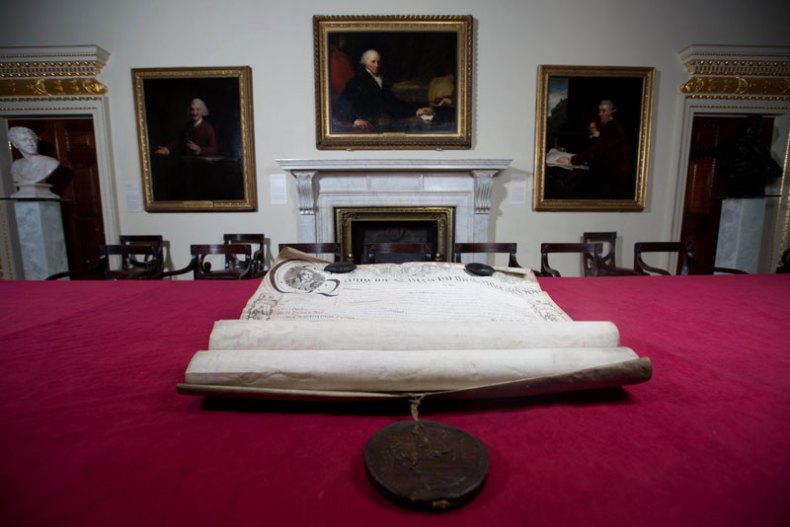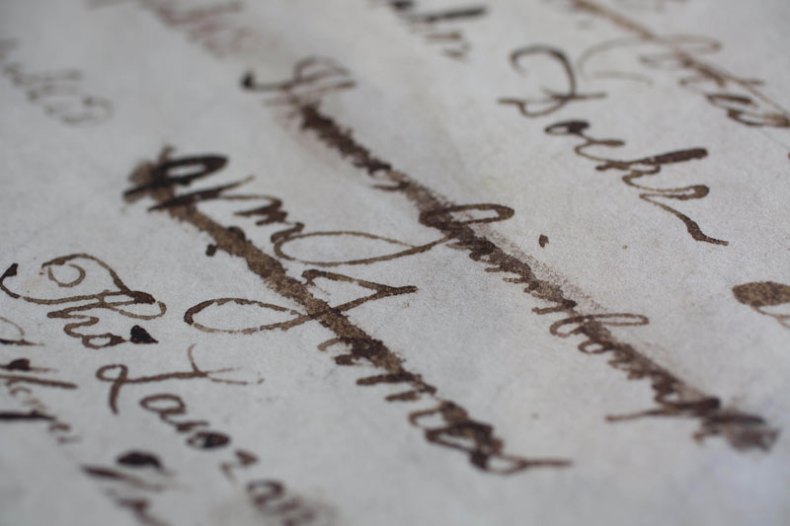There was a certain amount of news coverage recently about the fact that, in clearing the vaults and stores of the Royal Academy’s building in Burlington Gardens, our Collections staff came across a package of papers described as ‘Artists’ Memorabilia’.
They sensibly alerted the RA’s archivist, Mark Pomeroy, who realised that the papers included the long lost Charter of the Society of Artists, which was known about, but had not been seen by anyone since 1918, not even by Matthew Hargraves who did a PhD thesis on the Society of Artists, which was subsequently published under the title Candidates for Fame: The Society of Artists for Great Britain 1760–1791.

© David Parry
I was less interested in the Charter – it was always known that the Society of Artists had acquired a Royal Charter in 1765 – than in the discovery of the Society’s original Roll of Obligation. It replicates the Royal Academy’s own Roll of Obligation which every Royal Academician has been required to sign since 1768. I still have to read out its requirement that every Royal Academician must follow the relevant Laws, By-laws and Regulations to every artist who joins the Academy today.
Firstly, the Roll of Obligation shows that much of the language, ceremonial and general flummery surrounding the establishment of the Royal Academy pre-existed it. That was why it was possible to establish the Royal Academy in the space of two weeks between 28 November 1768, when the idea of establishing an Academy was first discussed with the King, and 10 December 1768, when the Royal Academy was founded, complete with a set of laws and the Roll of Obligation which was introduced four days later.

© David Parry
Secondly, there is a certain frisson in seeing the names of the original founders of the Royal Academy scratched out as traitors. Reynolds, Chambers, Gainsborough: we have been brought up to think of them as the great heroes of the 18th-century art establishment. But to many of their contemporaries they were skunks, who had deserted the more democratic Society of Artists in order to form a much more elitist and exclusive Academy under the auspices of, and subordinate to, the Crown.

An Unexpected Discovery at the Royal Academy
Royal Academy Archivist Mark Pomeroy with the Charter for the Society of Artists of Great Britain and its Roll of Obligation (1765), part of the RA Collections, much of which will go on display after the RA’s redevelopment is completed in 2018 © David Parry
Share
There was a certain amount of news coverage recently about the fact that, in clearing the vaults and stores of the Royal Academy’s building in Burlington Gardens, our Collections staff came across a package of papers described as ‘Artists’ Memorabilia’.
They sensibly alerted the RA’s archivist, Mark Pomeroy, who realised that the papers included the long lost Charter of the Society of Artists, which was known about, but had not been seen by anyone since 1918, not even by Matthew Hargraves who did a PhD thesis on the Society of Artists, which was subsequently published under the title Candidates for Fame: The Society of Artists for Great Britain 1760–1791.
© David Parry
I was less interested in the Charter – it was always known that the Society of Artists had acquired a Royal Charter in 1765 – than in the discovery of the Society’s original Roll of Obligation. It replicates the Royal Academy’s own Roll of Obligation which every Royal Academician has been required to sign since 1768. I still have to read out its requirement that every Royal Academician must follow the relevant Laws, By-laws and Regulations to every artist who joins the Academy today.
Firstly, the Roll of Obligation shows that much of the language, ceremonial and general flummery surrounding the establishment of the Royal Academy pre-existed it. That was why it was possible to establish the Royal Academy in the space of two weeks between 28 November 1768, when the idea of establishing an Academy was first discussed with the King, and 10 December 1768, when the Royal Academy was founded, complete with a set of laws and the Roll of Obligation which was introduced four days later.
© David Parry
Secondly, there is a certain frisson in seeing the names of the original founders of the Royal Academy scratched out as traitors. Reynolds, Chambers, Gainsborough: we have been brought up to think of them as the great heroes of the 18th-century art establishment. But to many of their contemporaries they were skunks, who had deserted the more democratic Society of Artists in order to form a much more elitist and exclusive Academy under the auspices of, and subordinate to, the Crown.
Unlimited access from just $16 every 3 months
Subscribe to get unlimited and exclusive access to the top art stories, interviews and exhibition reviews.
Share
Recommended for you
How Flashback Turin is winning contemporary collectors round to historic art
It’s motto? ‘All art is contemporary.’
The Very Best of the Venice Biennale
Visiting Venice? Don’t miss these shows
Asian Art in London 2015: Art Award Shortlist
Announcing the shortlist for the Asian Art in London Art Award 2015